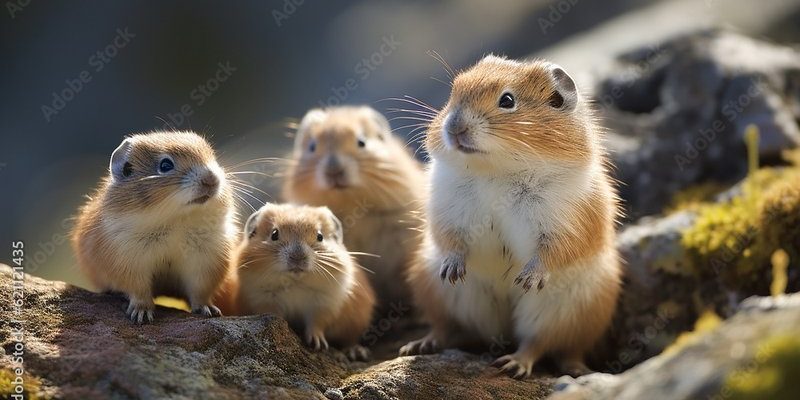
Lemmings are incredibly resourceful creatures. They thrive in some of the coldest, most unforgiving areas of the Arctic tundra and sub-Arctic regions. You might be wondering how these little guys manage to not only survive but actually reproduce and form large populations in such difficult conditions. Well, it turns out they have a mix of physical adaptations, behavioral strategies, and social structures that help them weather the worst of winters. Let’s dive into how lemmings do this.
Understanding the Lemming’s Habitat
Lemmings primarily live in the Arctic tundra, a landscape that’s characterized by cold temperatures, permafrost, and limited vegetation. This environment can seem inhospitable, but lemmings have adapted brilliantly to their surroundings. They dig extensive burrows that serve as shelter from the biting cold and predators. These burrows also help them find food—mostly grasses, roots, and other plants that grow during the brief summer months.
You might think that food would be scarce, but the lemming population has a unique relationship with its environment. The tundra undergoes a cycle of growth and dormancy, with plant life flourishing during the summer. When food is abundant, lemmings can reproduce quickly, and their populations can explode! But during winter, survival means being smart about food storage and relying on their burrowing skills to reach hidden treasures beneath the snow.
Physical Adaptations for Survival
Lemmings are equipped with several physical features that help them endure harsh conditions. Firstly, their thick fur coats provide excellent insulation against the cold. These coats can change color with the seasons—turning white in winter to blend in with the snow and brown in summer for camouflage among the tundra’s plants. This not only helps protect them from predators but also aids in regulating their body temperature.
Another impressive adaptation is their ability to forage under the snow. Lemmings are expert diggers, using their sharp claws to create tunnels and reach vegetation hidden below the snowpack. This not only keeps them fed but also allows them to avoid the frigid temperatures above. Additionally, their small size means they require less food than larger animals, making it easier to find enough nourishment to survive.
Behavioral Strategies
Let’s talk about how lemmings behave in their environment. One of their most fascinating survival strategies is their high reproductive rate. Under favorable conditions, lemmings can reproduce several times in a single summer, leading to population booms. This might sound chaotic, but it’s a key survival tactic: when food is plentiful, more lemmings mean a better chance that some will survive through the tough winter months.
Lemmings are also highly social animals. They live in colonies and often band together for various activities, such as foraging for food and watching for predators. You could think of it as a sort of lemming community watch! By working together, they can share information about where to find food and how to keep each other safe. That kind of teamwork goes a long way when times are tough.
Adaptation to Seasonal Changes
Surviving in the tundra means being prepared for dramatic seasonal changes. As summer turns to fall, temperatures drop and food sources become scarcer. Lemmings take advantage of the warmer months to stockpile food by storing it in their burrows. This critical preparation helps them get through the winter, when snow covers the ground and foraging becomes more challenging.
In winter, lemmings don’t just hibernate—at least, not in the way you might think. They remain active, using their tunnels to navigate the snow-covered landscape. They have also been known to enter a state of torpor, where their metabolism slows down to conserve energy. This allows them to go longer without fresh food while they wait for the warmer spring days to return.
Dealing with Predation
While lemmings are adept at surviving in their harsh environments, they are also prey for a variety of predators, including foxes, hawks, and owls. To counteract this threat, lemmings employ several survival tactics. Their small size allows them to hide easily among the rocks and grasses, and their incredible speed makes them difficult targets.
Another interesting strategy is their reproductive boom and bust cycle. During years of high population, predators have plenty of lemmings to feast on, but when the lemming numbers dwindle, predators may move on to other areas. This ebb and flow of the ecosystem keeps predator and prey populations in balance, allowing lemmings to bounce back when conditions improve.
Honestly, the life of a lemming is anything but simple. These tiny rodents showcase remarkable resilience, adapting to tough environments with clever strategies that keep them alive. Their burrowing skills, fast reproduction rates, and social behaviors are just a few examples of their incredible survival instincts.
The next time you hear someone joking about “lemming behavior,” remember that these little creatures are far more complex than they seem. Their ability to thrive in the Arctic tundra is a testament to nature’s ingenuity. Whether facing bitter cold or hungry predators, lemmings demonstrate that survival isn’t just about being tough. It’s about being smart, adaptable, and a little bit social, too. So next time you’re bundling up for winter, think of the lemmings and their amazing journey through one of nature’s most demanding environments.

